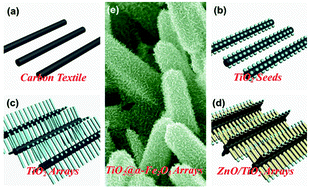Highly ordered TiO2@α-Fe2O3 core/shell arrays on carbon textiles (TFAs) have been fabricated by a stepwise, seed-assisted, hydrothermal approach and further investigated as the anode materials for Li-ion batteries (LIBs). This composite TFA anode exhibits superior high-rate capability and outstanding cycling performance. The specific capacity of the TFAs is much higher than that of pristine carbon textiles (CTs) and TiO2 nanorod arrays on carbon textiles (TRAs), indicating a positive synergistic effect of the material and structural hybridization on the enhancement of the electrochemical properties. This composite nanostructure not only provides large interfacial area for lithium insertion/extraction but should also be beneficial in reducing the diffusion pathways for electronic and ionic transport, leading to the improved capacity retention on cycling even at high discharge–charge rates. It is worth emphasizing that the CT substrates also present many potential virtues for LIBs as flexible electronic devices owing to the stretchable, lightweight and biodegradable properties. The fabrication strategy presented here is facile, cost-effective, and scalable, which opens new avenues for the design of optimal composite electrode materials for high performance LIBs.

You have access to this article
 Please wait while we load your content...
Something went wrong. Try again?
Please wait while we load your content...
Something went wrong. Try again?


 Please wait while we load your content...
Please wait while we load your content...